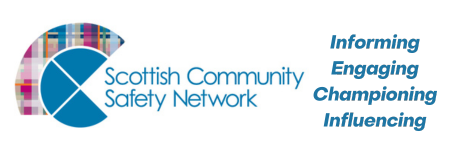The Scottish Community Safety Network recently published a significant piece of research. ‘Experiences and Perceptions of Community Safety in Scotland’, produced by Robyn Bailey, Social Researcher for the Scottish Government, was commissioned by SCSN as part of the Scottish Government’s analytical exchange programme. The research was launched at a webinar on 1st December 2020 with practitioners from across the community safety sector in Scotland.
Following on from this research and webinar, SCSN are proud to launch our new animation that captures key findings and information on how different people and groups experience community safety.
The animation is 2 minutes 10 seconds long and is intended be a used as a resource for practitioners working in community safety to quickly and effectively share the message that community safety is a diverse landscape with equally diverse experiences.
We invite partners to share this short animated film as a tool, to help increase awareness, spark dialogue and bridge understanding between Scotland’s residents, services and decision makers. You might publish it on your social media channels, present it as part of an event, or include it as a link in your email signature. You could highlight the film in a newsletter for staff and service users, or play it on shared screens in public spaces (e.g. reception areas). However you choose to share it, we really hope it helps you to engage folk, to consider what safety means for them and their neighbours.
More on our Experiences and Perceptions Research
SCSN have had a long-standing interest in what makes people safe; and a curiosity about the role that various factors, people and organisations play in creating safe communities. In February 2020 we found out we were successful in securing an analyst through the Scottish Government’s analytical exchange programme. The research that we are publishing today is the culmination of this work with Robyn Bailey during the summer months to better understand people’s experiences of safety throughout the life stages as well as understanding different communities’ experiences of safety. This project unpicks high level data about, and illustrates personal experiences of community safety, helping us to further our understanding of how to support safer communities in Scotland.
We hope this piece of work will help partners to further their work on prevention as well as influence their policy and practice to match this diversity in experiences of community safety. We will use it to influence our conversations about what makes a safe community and understanding how these things interact with one another to create inclusive, resilient and safe communities.
Key findings from the research include:
- Different groups feel safe and worry about crime to different degrees: Children and young adults, women, Minority Ethnic people, people with a disability, people in more deprived areas and in lower income households, people in urban areas and victims of crime generally feel less safe alone at night and worry about crime more in Scotland.
- Fear of crime is more apparent in particular groups such as minority ethnic people, LGBTQ communities and for women and girls. Fear of crime has an impact on wellbeing, the choices they make and can affect people’s experiences of life.
- There are major data gaps, especially around young children; trans and gender non-conforming people; lesbian, gay and bisexual people; specific minority ethnic groups in Scotland; and people with specific disabilities – as well as the need to understand experiences where there are intersections of these identities
- Groups may need tailored community safety strategies or responses from public services – some may benefit from neighbourhood schemes, or more interaction with police; and we also need to explore the root causes of feelings of safety and unsafety to be able to shift to more preventative approaches for better outcomes.
- Future research also needs to explore how these experiences have changed after COVID-19, e.g., older people, those with underlying health conditions and minority ethnic people are at a greater risk from the virus. In addition, those more susceptible to the virus may have their quality of life impacted more disproportionately due to policy measures such as social isolation, shielding and the resulting impact on loneliness and wellbeing.
Lorraine Gillies, Chief Officer of the Scottish Community Safety Network said that “We are delighted to be publishing this vital piece of work. It is essential that we design our community safety approaches and services for the benefit of ALL groups and communities. It was inspiring to hear participants at the launch event on 1st December reflect and discuss how community safety practitioners can work to embrace participative practice and pursue equality of experience for all within the field of community safety.”
